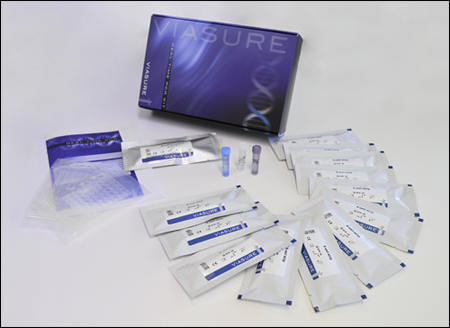
VIASURE Real Time PCR Detection Kits
Blastocystis hominis + Dientamoeba fragilis

Description
VIASURE Blastocystis hominis + Dientamoeba fragilis Real Time PCR Detection Kit is designed for specific detection and differentiation of Blastocystis hominis and/or Dientamoeba fragilis in human stool samples from patients with signs and symptoms of gastrointestinal infection.
This test is intended for use as an aid in the diagnosis of the Blastocystis hominis and/or Dientamoeba fragilis in combination with clinical and epidemiological risk factors.
DNA is extracted from stool specimens, multiplied using Real Time amplification and detected using specific primers and a fluorescent reporter dye probe for Blastocystis hominis and/or Dientamoeba fragilis.
Specifications
The Medical Device License (MDL) for this Class II in vitro diagnostic product for commercialization in Canada has been funded by the 2025 International Certification aid program of the Official Chamber of Commerce, Industry, Services and Navigation of Spain.

Information
Intestinal parasitic diseases occur worldwide, although their frequencies vary according to the region studied. The most common parasites are species of Cryptosporidium, Blastocystis hominis, Entamoeba, Giardia lamblia and Dientamoeba fragilis. In humans, parasitic infections can be asymptomatic, but some cases present diarrhea or other signs of gastroenteritis.
Initially classified as an amoeba, Dientamoeba fragilis is actually a protozoan parasite that belongs to the Trichonomad order and has been associated with gastrointestinal disease worldwide, showing symptoms such as: diarrhea, loose stools and/or abdominal pain with a highly variable incidence, ranging from 1.1 to 20%. Its way of transmission remains unclear, and both the faecal‐oral and vector transmission routes have been suggested.
Despite the high frequency when encountering D. fragilis, it is still neglected as a significant pathogen due to the lack of routinary diagnostics in many laboratories. Detection of D. fragilis trophozoites in permanent stained smears is the current standardized laboratory procedure for diagnosis. Blastocystis is a highly polymorphic enteric protozoon that takes several different forms during its life cycle, including: vacuolar, cystic, amoeboid, granular, multivacuolar, and avacuolar forms. Its pathogenicity remains controversial due to non‐specific symptoms such as: abdominal pain, nausea, vomiting, anorexia, flatulence, bloating, weight loss, acute or chronic diarrhea, and urticaria. In fact, recent microbiome and metagenomics studies suggest that Blastocystis colonization is usually associated with a healthy gut microbiota, rather than with the gut dysbiosis generally observed in metabolic or inflammatory diseases such irritable bowel syndrome (IBS). However, symptomatic Blastocystis infections have been more commonly encountered amongst these patients as well as HIV/AIDS and other immunocompromised individuals.
Microscopic stool sample examination for the detection of cysts, oocysts, and trophozoites remains the diagnostic method of choice for many laboratories. This is laborious and requires technical expertise; being also insensitive for low levels of infection. Meanwhile, molecular approaches involving PCR are becoming increasingly available for detecting intestinal parasites and demonstrate excellent sensitivity and specificity when compared to conventional methods.

